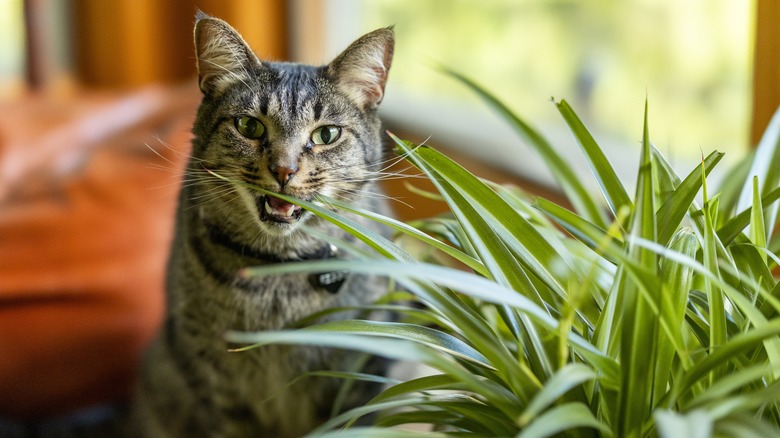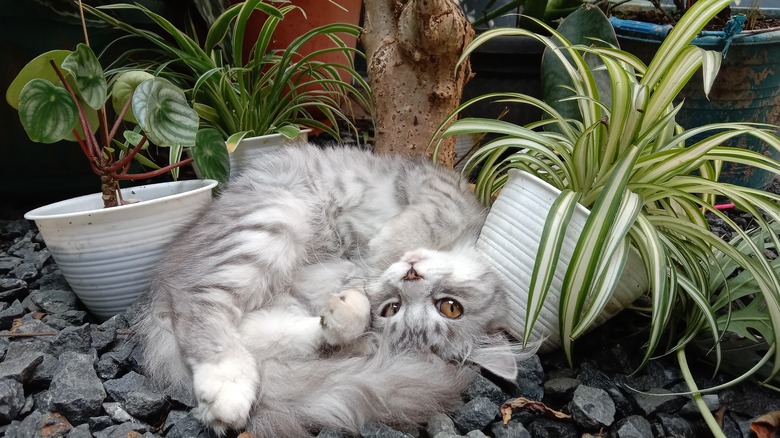Are Spider Plants Poisonous To Cats? Here's What You Should Know
The spider plant (Chlorophytum comosum) is one of the most popular houseplants, so named for its little baby "spiderettes." This plant is beloved for its bright green leaves and low-maintenance care needs, but just because a plant is popular doesn't mean it's a good choice for every household. Pet parents must be cautious about the types of plants they bring into their home, especially if they own cats. In general, cats are more likely than dogs to chew on houseplants and, unfortunately, can suffer more severe health consequences after ingesting a poisonous plant. Long, stringy tendrils and pom-pom-like spiderettes can make the spider plant seem like a tempting toy for cats, but is it safe for them to interact with? Houseplant lovers rejoice; this is one plant that is totally non-toxic for felines.
There are plenty of houseplants you should avoid if you have cats, but luckily, the spider plant isn't one of them. In fact, if your cat loves to sniff and roll around in catnip, they may enjoy nibbling on a few spider plant leaves, too! Here's what you need to know about growing spider plants around your feline friends and tips for ensuring your cat — and your plant — stay happy and healthy.
Spider plants are non-toxic and cat-friendly
The spider plant is a perennial, herbaceous plant and a member of the Asparagaceae family, native to South Africa. While it might have a creepy-sounding name, there's no need to fear the humble spider plant; it's perfectly safe for your pet to sniff, nibble, or chomp. The spider plant is even safe for humans to eat, although it doesn't taste great and has served medicinal purposes in parts of China and Africa. A spider plant can appeal to your cat for another funny reason: when eaten, it may produce mild hallucinogenic effects that are very similar to catnip!
Even though spider plants are non-toxic houseplants safe for any space, it's best not to let your cat get too carried away. Cats are obligate carnivores by nature, so eating too much plant matter coupled with this one's opium-like properties can cause mild gastrointestinal upset. Plus, you wouldn't want to come home to find your spider plant riddled with little tooth marks. For the sake of your cat, your plant, and your clean floors, it's best to put your spider plant in a place where Kitty can't reach it, but there's no need to panic if your pet ingests a few bites.
Where to keep your spider plant in a cat-friendly home
Spider plants are a safe houseplant choice for cat owners, but that doesn't mean you want your feline friend tearing into the leaves or scattering soil. By following a few simple ways to cat-proof your plants, you can ensure that your plant stays intact and out of reach. One of the easiest ways to keep your cat out of the plant is to put it in a hanging planter. Hanging your plant up high won't just keep it safe from Kitty's curiosity; it'll also help the plant look its best as the leaves and spiderettes hang downwards. If you want to allow your cat to interact with the plant, it can be easily brought down to the floor and then returned to its hook when your furry friend has had enough.
If you can't hang your spider plant, you can also keep it in a room where your cat won't be able to enter unsupervised. A bedroom or home office with a closed door is generally a good choice, but spider plants will also appreciate the humidity of a bathroom. If all else fails, spider plants can be moved outdoors but should be kept in a cool, bright place away from direct sunlight.


